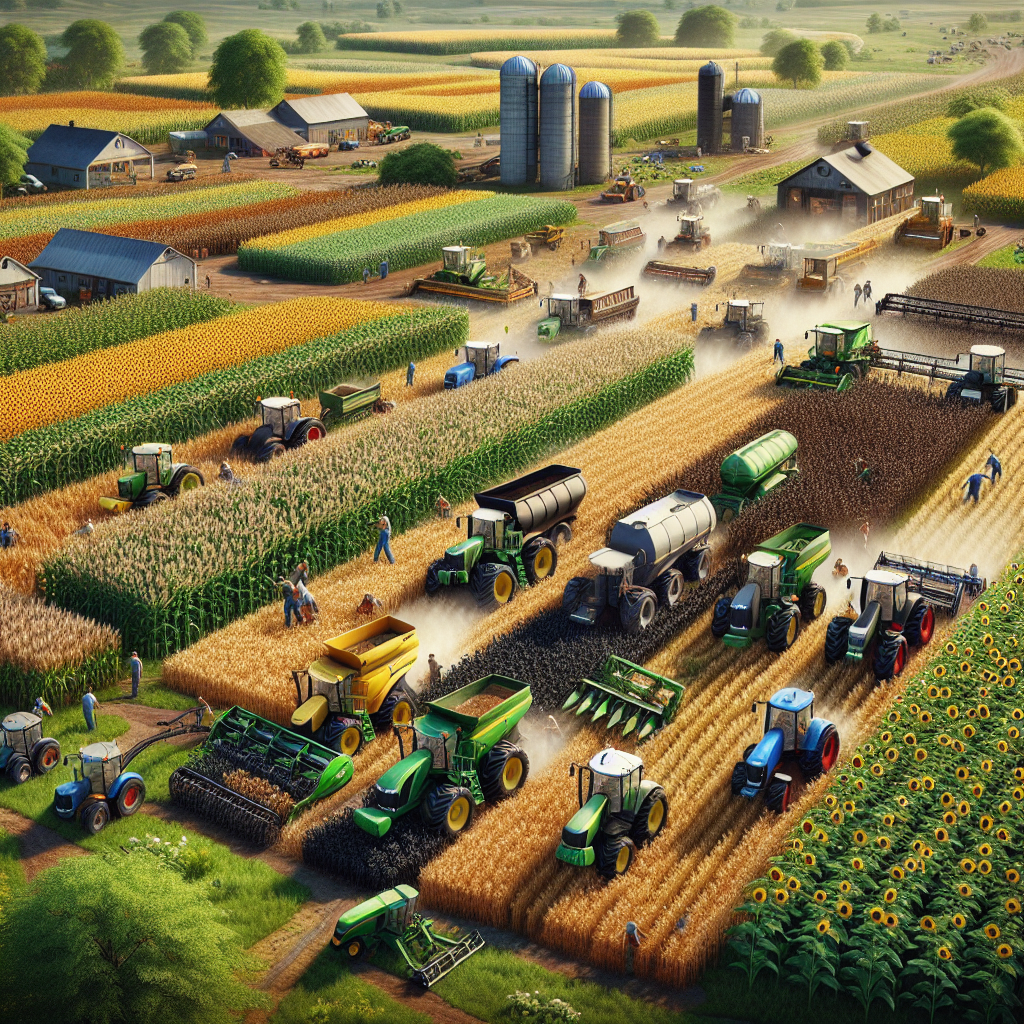“Farming Simulator 20” by GIANTS Software is a highly detailed and immersive agricultural simulation game, released as part of the popular Farming Simulator series. Version 4.3 of the game offers players an expansive and realistic farming experience, allowing them to manage their own farm, cultivate crops, raise livestock, and operate a wide range of authentic farming machinery. The game features enhanced graphics, improved mechanics, and a variety of new content, including additional crops, vehicles, and equipment from real-world agricultural brands. With its focus on realism and comprehensive gameplay, “Farming Simulator 20” provides both casual players and farming enthusiasts with an engaging and educational virtual farming experience.
Mastering Crop Management: Tips and Tricks for Farming Simulator 20
Farming Simulator 20 by GIANTS Software offers an immersive experience that allows players to delve into the intricacies of modern agriculture. Mastering crop management in this simulation requires a blend of strategic planning, timely execution, and a deep understanding of the game’s mechanics. To help you optimize your virtual farming operations, we present a series of tips and tricks that will enhance your crop management skills.
To begin with, selecting the right crops is crucial. Different crops have varying growth cycles, yield potentials, and market values. It is essential to diversify your crop selection to mitigate risks associated with market fluctuations and adverse weather conditions. For instance, while wheat and barley are staple crops with relatively short growth periods, crops like cotton and sugarcane offer higher profits but require longer cultivation times. Balancing your crop portfolio ensures a steady income stream and reduces dependency on a single crop type.
Transitioning to soil preparation, it is imperative to understand the significance of plowing, cultivating, and fertilizing. Plowing is necessary after harvesting root crops or when the field has not been plowed for a long time. This process helps in breaking up the soil, allowing for better water infiltration and root growth. Cultivating, on the other hand, is a less intensive process that prepares the seedbed for planting. It is advisable to cultivate the soil after plowing to create an optimal environment for seed germination.
Fertilization plays a pivotal role in maximizing crop yields. There are three stages of fertilization in Farming Simulator 20, and each stage contributes to the overall health and productivity of your crops. Using a combination of organic and synthetic fertilizers can provide a balanced nutrient supply. Manure and slurry are excellent organic options, while synthetic fertilizers offer a quick nutrient boost. It is important to monitor the nutrient levels in your fields and apply fertilizers at the appropriate stages of crop growth to ensure maximum efficiency.
Moreover, weed control is an often-overlooked aspect of crop management. Weeds compete with crops for nutrients, water, and sunlight, significantly reducing yields if left unchecked. Regularly using herbicides or mechanical weeders can help maintain a weed-free environment. It is advisable to scout your fields frequently and address weed infestations promptly to prevent them from spreading.
Irrigation is another critical factor that influences crop health. Ensuring that your crops receive adequate water is essential for their growth and development. While some maps in Farming Simulator 20 come with built-in irrigation systems, others may require you to invest in irrigation equipment. Monitoring soil moisture levels and adjusting your irrigation practices accordingly can prevent water stress and promote healthy crop growth.
Harvesting at the right time is the final step in successful crop management. Each crop has an optimal harvest window, and harvesting too early or too late can result in reduced yields and quality. Using the in-game calendar and growth stage indicators can help you determine the best time to harvest. Additionally, investing in efficient harvesting equipment can expedite the process and reduce crop losses.
In conclusion, mastering crop management in Farming Simulator 20 involves a comprehensive approach that encompasses crop selection, soil preparation, fertilization, weed control, irrigation, and timely harvesting. By implementing these tips and tricks, you can enhance your farming operations and achieve higher productivity and profitability in the game.
Exploring the Best Machinery in Farming Simulator 20: A Comprehensive Guide

Farming Simulator 20, developed by GIANTS Software, offers an immersive experience for those interested in the agricultural industry. The game provides a detailed simulation of farming activities, allowing players to manage their own farms, cultivate crops, and raise livestock. One of the most compelling aspects of Farming Simulator 20 is the extensive range of machinery available, which plays a crucial role in enhancing the farming experience. This article aims to explore the best machinery in Farming Simulator 20, providing a comprehensive guide to help players make informed decisions.
To begin with, tractors are the backbone of any farming operation in Farming Simulator 20. The game features a variety of tractors from renowned manufacturers such as John Deere, Case IH, and New Holland. Each tractor comes with its own set of specifications, including horsepower, fuel capacity, and speed. For instance, the John Deere 8R Series is highly recommended for its powerful engine and versatility, making it suitable for a wide range of tasks from plowing to transporting goods. On the other hand, the Case IH Magnum Series offers excellent fuel efficiency and durability, making it a reliable choice for long-term use.
Transitioning from tractors, it is essential to consider the importance of harvesters in the game. Harvesters are specialized machines designed to efficiently gather crops from the fields. The Claas Lexion 8900 is a standout model in Farming Simulator 20, known for its high capacity and advanced technology. This harvester can handle large fields with ease, significantly reducing the time required for harvesting. Additionally, the New Holland CR10.90 is another excellent option, offering a perfect balance between speed and capacity. Its innovative design ensures minimal crop loss, maximizing yield and profitability.
Moving on to planting equipment, seeders and planters are indispensable for successful crop cultivation. The Horsch Pronto 9 DC is a versatile seeder that supports a wide range of crops, including wheat, barley, and canola. Its large working width and high-speed capabilities make it an efficient choice for large-scale farming operations. Similarly, the John Deere 1775NT planter is highly regarded for its precision and reliability. This planter ensures uniform seed placement, promoting optimal crop growth and yield.
In addition to planting equipment, players must also invest in fertilizing machinery to enhance soil fertility and boost crop production. The Amazone ZG-TS 10001 is a top-tier fertilizer spreader in Farming Simulator 20, offering a large capacity and wide spreading width. This machine allows for quick and efficient fertilization, ensuring that crops receive the necessary nutrients for healthy growth. Furthermore, the Kuhn Axis 40.2 M-EMC-W is another excellent choice, featuring advanced technology that ensures even distribution of fertilizer, minimizing waste and maximizing efficiency.
Lastly, it is crucial to address the role of transportation machinery in Farming Simulator 20. Trailers and trucks are essential for transporting harvested crops, livestock, and other materials. The Fliegl ASS 298 is a highly recommended trailer, known for its large capacity and durability. This trailer can handle heavy loads with ease, making it ideal for transporting large quantities of crops. Additionally, the MAN TGS 18.500 truck offers excellent performance and reliability, ensuring smooth and efficient transportation across the farm.
In conclusion, Farming Simulator 20 provides a wide array of machinery that significantly enhances the farming experience. From powerful tractors and efficient harvesters to versatile planting equipment and reliable transportation machinery, each piece of equipment plays a vital role in ensuring the success of farming operations. By carefully selecting the best machinery, players can optimize their farm’s productivity and profitability, making Farming Simulator 20 a truly rewarding experience.
Maximizing Profits: Effective Farm Strategies in Farming Simulator 20
In the realm of virtual agriculture, Farming Simulator 20 by GIANTS Software offers players an immersive experience that mirrors the complexities of real-world farming. To maximize profits in this simulation, it is essential to adopt effective farm strategies that encompass a range of activities from crop selection to machinery management. By understanding and implementing these strategies, players can ensure their virtual farms thrive economically.
To begin with, crop selection plays a pivotal role in determining the profitability of a farm. Different crops have varying growth cycles, market values, and maintenance requirements. For instance, high-yield crops such as wheat and barley are relatively easy to cultivate and can be harvested multiple times within a season. Conversely, crops like cotton and sugarcane, while potentially more lucrative, demand more intensive labor and longer growth periods. Therefore, it is crucial to balance the cultivation of quick-growing crops with high-value ones to maintain a steady income stream.
Transitioning from crop selection to soil management, the importance of soil health cannot be overstated. Fertilization, plowing, and crop rotation are fundamental practices that enhance soil fertility and, consequently, crop yields. Utilizing organic and inorganic fertilizers judiciously ensures that the soil remains nutrient-rich. Additionally, plowing fields after each harvest helps in aerating the soil and preventing weed growth. Crop rotation, on the other hand, mitigates the risk of soil depletion and pest infestations, thereby sustaining long-term productivity.
Machinery management is another critical aspect that significantly impacts farm profitability. Investing in high-quality, efficient machinery can reduce labor costs and increase operational efficiency. Tractors, harvesters, and planters should be selected based on the specific needs of the farm. For example, a large-scale farm may benefit from advanced, high-capacity machinery, whereas a smaller farm might find mid-range equipment more cost-effective. Regular maintenance of machinery is equally important to prevent breakdowns and ensure smooth operations.
Furthermore, diversification is a strategy that can safeguard against market volatility and enhance profitability. In addition to traditional crop farming, players can explore livestock farming, forestry, and even greenhouse cultivation. Livestock farming, including dairy and poultry, provides a steady source of income through the sale of milk, eggs, and meat. Forestry, involving the planting and harvesting of trees, offers long-term financial gains. Greenhouse cultivation allows for the production of high-value crops such as tomatoes and lettuce, irrespective of seasonal constraints.
Marketing and sales strategies also play a vital role in maximizing profits. Keeping abreast of market trends and prices enables players to sell their produce at the most opportune times. Establishing contracts with local businesses and participating in farmers’ markets can provide stable revenue streams. Additionally, investing in storage facilities allows players to hold onto their produce until market prices are favorable, thereby maximizing returns.
Lastly, financial management is the backbone of a successful farming operation. Keeping track of expenses, loans, and revenues ensures that the farm remains financially viable. Budgeting for essential expenditures such as seeds, fertilizers, and machinery maintenance helps in avoiding unnecessary debts. Moreover, reinvesting profits into farm expansion and technological upgrades can lead to increased productivity and higher profits in the long run.
In conclusion, maximizing profits in Farming Simulator 20 requires a multifaceted approach that encompasses strategic crop selection, effective soil management, efficient machinery use, diversification, astute marketing, and sound financial management. By meticulously planning and executing these strategies, players can transform their virtual farms into thriving, profitable enterprises.Farming Simulator 20 by GIANTS Software is a highly detailed and immersive simulation game that offers players a realistic farming experience. With a rating of 4.3, it is well-received for its comprehensive mechanics, extensive range of farming equipment, and the ability to manage various aspects of a farm, from planting crops to raising livestock. The game provides a satisfying blend of strategy and hands-on activities, making it a popular choice for both casual gamers and farming enthusiasts.




